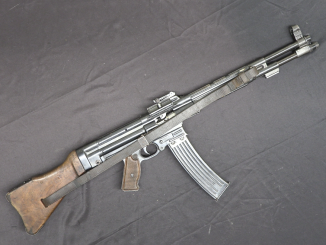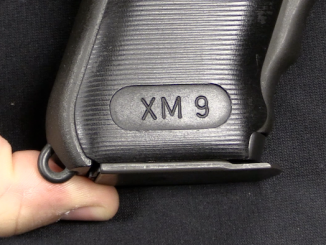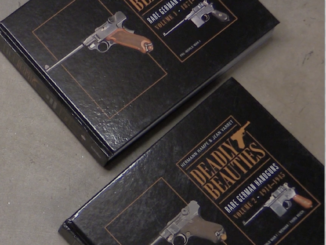Early in the production of the C96 Mauser, the company tried a variety of different configurations of the pistol, to see what would be popular and sell well. Most of these were abandoned by about 1902, when the design was more or less standardized to the version were are familiar with today. One of the early experiments was with a 20-round fixed magazine, or which 188 were made. This was fed using two 10-round stripper clips, and that seems to have been the biggest problem with it. According to some folks who have used these, the magazines is quite difficult to fully load, making the 10-shot version rather more practical. There are counterfeits of these being made, so one must be careful when making a purchase – but this particular one came from the collection of Dr. Geoffrey Sturgess, which gives it plenty of legitimacy in my book.
© 2025 Forgotten Weapons.
Site developed by Cardinal Acres Web Development.




Astra later made their own version of this one, the Model 902. It was selective-fire like most of their Broomhandle clones in the 900 series, and its holster-stock included a moulded-leather cover to protect the extended magazine when it was stored.
Clients (probably in China) reportedly liked the 20-shot capacity. But there must have been a few remarks about the fixed setup because the next version, the 903, had a detachable box arrangement like the Mauser 712 with both 10 and 20-shot boxes; the gun could only be holstered in its stock with the 10-shot in place or with the well empty (naturally).
Personally, I think any of the above, from the 20-shot Conehammer on down, would be a nasty surprise for a would-be Einstein on the other side of a gunfight.
“OK, he has to reload when he’s fired ten shots. There’s ten! GET HIM!”
Oops.
cheers
eon
I thought the biggest round capacity before the M712 was only for the shock-trooper M1917 C96 carbine variant with 40 round detachable magazine…
Given a choice of Mauser weapons, which one (or ones) would you grab up if you were on a train and horse-riding train-robbers were coming your way? I’ve left the following in a box car (and presumably you and your friends are guarding a very big safe full of gold bars in that box car!!!!):
1. Regular C96 pistols (you may dual wield if you prefer)
2. C06 pistol (try to find some pics)
3. 1889 Mauser rifle variants chambered for 7.65 Argentine
4. 1896 Mauser rifles chambered for 6.5 Swedish Mauser or 7×57.
5. Any long rifles of the Gewehr 98 family (sniper and 20 round trench variants are around for some reason)
6. Carbines of the Gewehr98 family (namely the Kar 98 a and the WWII K98)
7. 1910 Mauser blowback pistol family
8. Mauser Zig-zag revolvers (both the solid frame version and the hinge-frame version)
9. Paul Mauser’s recoil-operated selbstladegewehr family
10. Gewehr 41 (M)
11. MG-34 and MG-42 (more dakka, anyone?)
12. 20 round C96 or Carbine version of C96, including M1917 trench carbine with 40 round mag.
13. M712 Schnellfueur
14. (add any of your favorite “toys” to this list!!!)
Reach the train station to win! Kill all the train robbers to win! Do whatever it takes TO WIN! Because believe me, you don’t want to lose!! [maniacal laugh!!]
When it’s a defensive situation on a moving “blockhouse”, the hands-down winner will be the belt-fed GPMGs, no contest. You don’t bring a knife to a gunfight, you don’t bring a pistol to a rifle fight, and bringing a rifle to a machine gun fight just makes you look stupid while you’re getting filled full of holes.
BTW, back in the “old days”, more than a few train robberies ended abruptly when the bandits opened up the side freight door of the Wells Fargo or U.S. Railway Post Office car, and found themselves looking at the wrong end of a .45-70 Camel Gatling.
Just hope none of the bandits has a few sticks of Giant Powder Co. goodies.
“Think you used enough dynamite there, Butch?”
cheers
eon
14. Oh, either a SIG MKMS “submachine carbine” in 9×25 Mauser or one of those vertical-foregrip MP-34s in .45 ACP that Steyer made for the South American trade… for some odd reason (too many movies, most likely) I’m seeing myself so armed as one of the banditos (that’s “revolutionary” to you, gringo!) on horseback and hoping that the imperialist lackeys guarding the gold didn’t take Eon’s advice and arm themselves with a Marine Corps-surplus 1895 Browning potato-digger in 6mm Lee…..
Loading the C96 without clip is considered hard. But, in fact, there is a fairly easy way to achieve this. The breechbolt back has a downward lug at far underside. The contour of piece first goes down and then runs upward forming a backward obstruction at that section. If the breechbolt is drawn fully rearward as watching the hammer’s top to enter just in front of that location, very slight support of thump or rised web of upper hand gives enough power to stop the breechbolt at back permitting to load cartridges singularly with other hand. Releasing the hold causes the bolt to run forwards to load the chamber. It needs some getting used to but, it is practical than others.
It is called as “Strongarm Hold”. Heh he…
Clarification; Slight pressure should be applied to the backside of hammer.
Another dirty trick to top-load a Broomhandle with the 20-shot box is to use the stripper clip for the first 10 rounds, then just leave the clip in place holding the bolt open while you load the next ten individually. Then just pull the stripper up and out, and proceed as usual.
It’s less convenient than just using a second strip, but also less of a juggling act than most other methods.
All of the above shows why Mauser went to a detachable box magazine on the 712 series. There’s really no substitute for a spare fully-loaded box in the fast reload department.
cheers
eon
The base of the extended fixed magazine would make a handy bludgeon in hand to hand SMACK! to the noggin.
Hard to find a good holster, I’d guess.
Going back a score of years, I saw a Cased Pair of C96s, (Early Model) with DETACHABLE Lower section of the 20 round capacity Mag…Ie, Like the WWI Gew98 Extension Mag.
The Extension slotted in as a perfect fit to a “Normal” C96 Frame, with a Longer spring. ( replacing the Normal Mag. FloorPlate.)
Obviously not a “Quick change” Option, as a pin or screwdriver was needed to remove the Floorplate and Spring/Elevator, and replace it with the Extension.
But a “Cased Pair” arrangement obviously meant it was a “Special order” with the extensions Hand-made and fitted to each gun ( to which they were Numbered.)
There were no details as to who was the original client. ( But obviously the “Guns of a Gentleman”, as the London Auction Houses describe items.).
Doc AV
Wow, that would be neat to see!
My reply is in the way of a reflection on how a new invention resembles the one it replaces: early automobiles and horse buggies; early pistols and revolvers: magazine before the trigger. I am not sure who first introduced the magazine in the handle: Luger/Parabellum seems a likely guess. Yet he still kept the barel unprotected with the Browning slide: fantastic balance, but less functonal in the trenches.
Incidentally – what would be the balance of the Mauser with a 20 rounds magazine?
The Salvator-Dormus 8mm (1894), Silverman-Maxim (1896), and Schwarzlose Standart (1896-97) all had their magazines in their pistol grips. The 1893 Borchardt, the direct ancestor of the Parabellum, seems to have been the first self-loader with this arrangement.
The multiplicity of early designs with the magazine out in front of the trigger guard may have been due to the numerous manual repeating pistols such as the Bittner (1883), Krnka (1886), Reiger (1886), Passler & Seidel (1887), and Laumann (1891), all of which had either clip-loading, enclosed Mauser-type box, or (in the case of the Krnka) a Mannlicher-type rotary magazine “up front”.
There were also a few with Winchester-type under-barrel tubular magazines and lever action mechanisms, one by Mauser, another by Osterreich, and a couple from Belgium. If you ever watched the old Sci-Fi Channel series “The Secret Adventures of Jules Verne”, one of the latter showed up now and then in the hands of Phileas Fogg, apparently supposed to be some form of (for the 1870s) top-secret advanced self-loader prototype, since you never saw him racking the action by hand.
The front-mounted magazine was conceived mainly to allow for the bolt travel of the manual repeaters and early self-loaders without having the bolt going too far aft in the shooter’s face. Why they would care on a gun intended to be fired at arm’s length is a good question.
Another factor was that some designers of the early autoloaders were concerned that the length of the cartridges (like the 7.63 x 25mm) couldn’t be accommodated in a grip-mounted magazine without rendering the grip too long front-to-back for a proper hold. (Anyone who has tried to use a modern Desert Eagle or AutoMag III “one-handed” can probably understand their concern.)
I suspect the manual repeaters also had this setup because it’s just easier to build what is usually a form of trigger-guard actuated lever-action system with the magazine in front rather than in back, unless you have a shoulder stock to stick the magazine in (Spencer, Winchester-Hotchkiss, Evans, Schulhof, etc.).
Incidentally, Schulhof also had a manual repeating pistol, patented in 1894, near the end of the repeater “period”. Just to confuse everyone totally, it loaded through a flap below the ejection port like a “front-magazine” type, but its tubular magazine was housed in its curved pistol grip. Go figure.
(Ezell, Handguns of the World, pp.133-154.)
cheers
eon
In just a few minutes, I’ll be posting a video of one of those Schulhof pistols with the tubular magazine… 🙂
Thank you Eon, Andrzej.
I’m surprised you didn’t mention that this was used as the basis for the blasters in Star Wars. Unless I missed it.
The C96 was the basis for that prop, but a normal 10-round version and not this type.